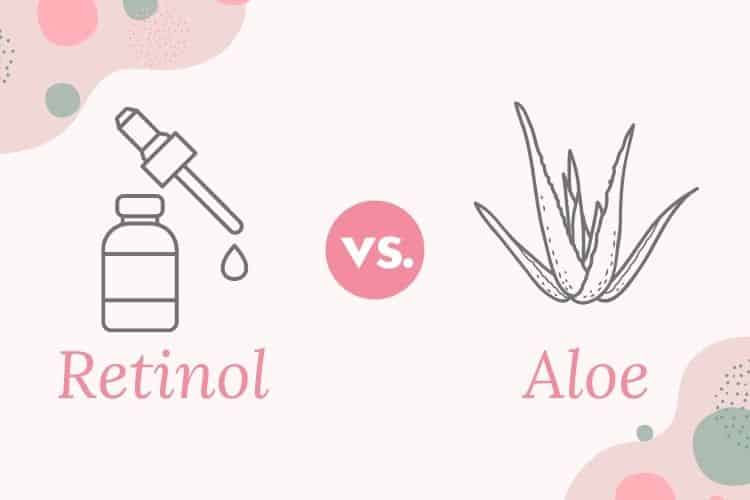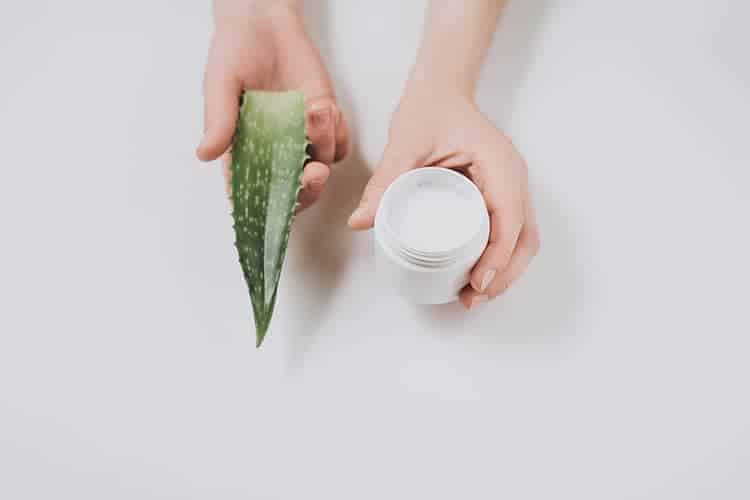
If you’re trying to decide between retinol vs aloe vera, or if you want to use them together but you’re not sure how, then you’re in the right place.
In this quick guide, you’re going to get the scoop on:
- The main benefits of aloe and retinol.
- How to layer and incorporate them into your beauty routine.
- Some products you can use to get started.
Let’s get to it!
Note: this post contains affiliate links and I earn a commission (at no additional cost to you) if you use them to make a purchase.
DOES ALOE VERA CONTAIN RETINOL?
Aloe vera does not contain retinol. Rather, it contains beta carotene, which the body converts to retinyl esters. These retinyl esters – as well as retinol – are generally referred to as preformed vitamin A, which is the most common form of retinoid in the body (1, 2).
So, while aloe vera may produce the same visual results as retinol, the main ingredients that contribute to those results are different.
BENEFITS OF RETINOL VS ALOE VERA GEL FOR SKIN

| RETINOL | ALOE VERA | |
|---|---|---|
| Stimulates collagen production | ✓ | ✓ |
| Helps with acne | ✓ | ✓ |
| Fades darks spots | ✓ | ✓ |
| Contains vitamins and minerals | ✓ | |
| Soothes redness | ✓ |
To start off, let’s look at the main benefits of retinol (sources: 3, 4, 5, 6):
- Supports skin renewal: retinol’s biggest claim to fame is that it stimulates collagen and elastin production. So, whether you’re looking to improve wrinkles, fade dark spots or even, improve acne, retinol just might do the trick.
- Gentler than prescription retinoids: compared to prescription strength retinoids, over-the-counter retinol is gentler on the skin and less likely to cause irritation (though it can still happen). In addition, since retinol is a gentler retinoid, it can take longer to produce results. So, give it up to a few months in order to experience its full effects.
- Unclogs pores: retinoids can help to unclog pores, a benefit that may reduce acne and prevent the formation of acne scars.
Now, let’s switch over to the benefits of aloe vera gel (sources: 7, 8, 9, 10, 11, 12, 13)
- Excellent counterpart to tretinoin: according to this small study, using 50% aloe vera gel and 0.05% tretinoin (prescription strength retinoid) leads to a significant reduction in acne lesions (compared to using the tretinoin without aloe). The study also shows that the aloe-tretinoin combination produces less redness. This isn’t very surprising given that aloe is very calming, making it an ideal complement to all retinoids (which are often drying and irritating).
- Supports production of collagen, elastin and hyaluronic acid: topical application of aloe vera stimulates fibroblasts, which are the cells that produce collagen, elastin and hyaluronic acid. Therefore, it’s easy to see why aloe is often used to improve skin hydration and suppleness, as well as to minimize fine lines and wrinkles.
- Moisturizing: Since aloe is mostly water, it’s a powerhouse for moisture and hydration. Furthermore, aloe contains sugar molecules called mucopolysaccharides, that act as humectants (i.e. attracts water to the skin).
- Natural exfoliant: aloe contains enzymes that exfoliate the skin and amino acids that soften the skin. Together, these compounds help to balance the overall appearance of skin.
- Home remedy for acne: as a natural source of salicylic acid, aloe may be helpful in diminishing pimples. Plus, aloe has anti-inflammatory inflammatory properties that can be very soothing for irritated, acne-prone skin.
- May improve hyperpigmentation: aloe contains vitamins A, C and E, which are all known for encouraging cell turnover and balancing skin tone. And if that’s not enough, it also contains a compound called aloesin, that can improve UV-induced discoloration.
- Supports wound healing: research indicates that burn patients who are treated with aloe heal faster than those who are treated with 1% silver sulfadiazine (an antibiotic cream that is often used for wounds). This is probably due to the fact that aloe actually speeds up a process called re-epithelialization (which involves regeneration of the epidermis).
- Diverse nutrient profile: one reason why aloe seems to do so much for the skin is that it contains approximately 75 components. These include vitamins, minerals (such as zinc and selenium), antiseptic compounds and sterols (which are both emollient and anti-inflammatory).
HOW TO USE ALOE VERA AND RETINOL: TIPS FOR LAYERING AND MIXING

There are two main guidelines to follow when mixing aloe vera and retinol in your skin care routine:
- If you are using pure aloe vera gel, apply it first, followed by the retinol product (cream, lotion or serum).
- If you are using an aloe-containing moisturizer, it’s generally better to apply the retinol first.
Do keep in mind that for the second scenario, you might have to do some trial and error.
For example, if your aloe moisturizer is a light lotion and your retinol product is a heavy cream, then you’ll actually be better off applying the light lotion first.
On the other hand, if your aloe moisturizer is a rich cream while your retinol product is a serum, then you should apply the serum first, followed by the aloe-based moisturizer.
Lastly, when using a retinol product, there are a few important things to keep in mind (source):
- low strength retinol (between 0.01 – 0.03%) is best if you’ve never used this ingredient before and/or you have dry or sensitive skin.
- medium strength retinol (between 0.03 – 0.3%) is more suitable for anyone struggling wanting to balance skin texture, tone or firmness.
- high strength retinol (between 0.3 – 1%) is better for very noticeable imbalances in skin tone and stubborn wrinkles.
- if you’ve never used retinol before, start by using it once a week. Then work your way up to twice or three times a week. This gives you enough time to monitor your skin and make sure that the retinol isn’t too drying or irritating for you.
- since retinol increases photosensitivity, it’s best to use it at night.
TOP ALOE AND RETINOL PRODUCTS TO START WITH
1. Honestly Pure Retinyl Serum from Honest Company
Rather than use straight retinol, this serum uses retinyl linoleate, which is a vitamin A derivative that is converted to retinoic acid (the active form that the body can actually use). To put that in perspective, retinol must also be converted to retinoic acid in order for skin to reap its benefits.
Aside from retinyl linoleate, the other standout ingredients in this serum are squalane and hyaluronic acid, which help to keep the skin moisturized and pliable.
2. Phyto Retinol Vitamin A Booster from True Botanicals
If your skin is sensitive to synthetic retinol – even in lower strengths – then you’ll want to grab this plant-based alternative.
It is loaded with ingredients that are known for being rich in beta-carotene (pro vitamin A) such as carrots, rosehips, buriti fruit, apricots, calendula flower, olives, sea buckthorn and more.
Since it’s all plant-based, it doesn’t have the same irritation factor or photosensitizing issue that comes with regular synthetic retinol.
Get this natural retinol alternative here.
3. Retinol Restorative Overnight Balm from 100% Pure
This soothing balm combines plant-derived retinol and a gentle vitamin C derivative (ascorbyl palmitate) with soothing oils (sunflower, olive) and butters (avocado and shea).
Since this is a balm, it is quite thick and a little goes a long way. Due to the consistency this is a good option for dry or mature skin that needs serious skin barrier support in addition to potent anti-aging ingredients.
FAQs ABOUT RETINOL AND ALOE VERA FOR SKIN
Is aloe vera good for under eyes?
Due to its gentle, hydrating and moisturizing properties, aloe vera is great for the delicate skin around the eyes. If using the gel (whether from a plant or store-bought gel), be sure to follow up with a moisturizer or serum. This will lock in the precious moisture from the aloe and keep the skin more supple.
Is aloe vera a toner or moisturizer?
Aloe vera is a natural moisturizer, not a toner. However, it contains nutrients like zinc, which has astringent properties that tighten pores (similar to most toners).
CONCLUSION
Overall, aloe vera can be as good as retinol because it supports skin renewal (by boosting collagen and elastin production), balances skin tone and helps with acne. For those with sensitive skin, aloe may be a better choice because it is anti-inflammatory and very calming.
I hope this article helped you get a better understanding of what these ingredients have to offer and how you can use them to reach your skin care goals!
You Might Also Like:
Aloe Vera vs Hyaluronic Acid: Are They Similar? | How to Add to Skincare Routine
Aloe Vera or Shea Butter for Sunburn: Which Is Better?
Vitamin C Serum vs Aloe Vera Gel: Benefits, Differences, Which Is Better and How to Use
Honey vs Aloe Vera for Face: Benefits, Best Ways To Use and Recipes

